The Complete Guide to Employee Time Tracking
Unlock the full potential of your team’s productivity with this comprehensive guide to employee time tracking, packed with methods, tools, and best practices for effective time management.
Effective time management is the backbone of any successful business. Whether you’re managing a small team or overseeing a large organization, understanding how time is spent can make a significant difference in productivity, accountability, and overall performance. Employee time tracking is a powerful tool that helps businesses monitor work hours, optimize task allocation, and ensure projects stay on schedule.
This comprehensive guide dives deep into the world of employee time tracking, exploring its benefits, methods, tools, and best practices to help you maximize efficiency and achieve your business goals.
What is Employee Time Tracking?
Employee time tracking involves recording the hours employees spend on tasks, projects, or specific activities during their workday. This process provides insights into how time is utilized, helping managers and team members identify areas for improvement. From manual timesheets to advanced software solutions, time tracking has evolved into a critical component of modern business operations.
Time tracking isn’t just about clocking in and out. It’s about understanding productivity patterns, ensuring fair compensation, and aligning efforts with organizational objectives. By implementing employee time tracking, businesses can gain a clearer picture of how resources are allocated, making it easier to manage projects, meet deadlines, and maintain a balanced work environment.
Why Employee Time Tracking Matters
Time is a finite resource, and managing it effectively can transform how a business operates. Here are some key reasons why employee time tracking is essential:
1. Boosts Productivity and Accountability
Tracking time encourages employees to focus on their tasks and take ownership of their responsibilities. When team members know their hours are being monitored, they are more likely to stay on task and avoid distractions. This increased accountability leads to higher productivity levels and better use of work hours.
2. Improves Project Management
For project-based teams, time tracking provides valuable data on how long tasks take to complete. This information helps managers create realistic timelines, efficient resource allocation, and avoid overcommitting to tight deadlines. By understanding time allocation, businesses can deliver projects on time and within budget.
3. Enhances Payroll Accuracy
Accurate time tracking ensures employees are paid fairly for the hours they work. This is particularly important for hourly workers, freelancers, and contractors. By using reliable time tracking tools, businesses can avoid payroll errors, reduce disputes, and maintain trust with their workforce.
4. Supports Remote and Hybrid Teams
With the rise of remote work, managing distributed teams has become a challenge. Remote employee time tracking software offers a solution by providing visibility into how remote workers spend their time. These tools help managers ensure that tasks are completed on schedule, regardless of where employees are located.
5. Informs Data-Driven Decisions
Time tracking data provides actionable insights that can guide business decisions. For example, if a particular task consistently takes longer than expected, managers can investigate the cause and address inefficiencies. This data-driven approach helps businesses optimize operations and allocate resources more effectively.
Methods of Employee Time Tracking
There are several ways to track employee time, each with its own advantages and challenges. Choosing the right method depends on your business needs, team size, and work environment. Below are the most common approaches:
Manual Time Tracking
![]()
Manual time tracking involves employees recording their hours on paper timesheets, spreadsheets, or simple apps. This method is straightforward and low-cost, making it suitable for small businesses or teams with minimal tracking needs.
Advantages:
- Easy to implement for small teams
- Requires minimal setup
- Cost-effective for businesses with limited budgets
Challenges:
- Prone to errors and inaccuracies
- Time-consuming for employees to log hours
- Lacks real-time insights
Punch Card Systems

Punch card systems use physical or digital clocks to record when employees start and end their shifts. These systems are common in industries like retail, manufacturing, and hospitality.
Advantages:
- Simple and widely understood
- Provides a clear record of attendance
- Reduces manual data entry
Challenges:
- Limited to tracking start and end times
- Not ideal for task-based or remote work
- Can be susceptible to time theft (e.g., buddy punching)
Biometric Time Tracking
![]()
Biometric systems use fingerprint, facial recognition, or iris scans to record employee attendance. These systems are highly accurate and eliminate issues like buddy punching.
Advantages:
- Highly secure and accurate
- Prevents time theft
- Tracks real-time attendance
Challenges:
- Higher upfront costs
- May raise privacy concerns among employees
- Requires hardware installation
Using Employee Time Tracking Software
Employee time tracking software allows employees to log hours through desktop or mobile apps, often with advanced features like project tracking, real-time monitoring, and integrations with payroll or project management tools. These tools are ideal for remote teams, freelancers, and contractors, offering flexibility and robust reporting.
Pros:
- Perfect for remote and field workers
- Features like stopwatch notifications, and analytics
- Syncs with payroll and project management systems
- Supports data-driven insights for productivity and efficiency
Cons:
- Requires reliable internet access
- May need employee training
- Can be distracting if misused
Recommended Tools:
- Free time tracking apps for freelancers: Toggl Track and Clockify offer free plans for tracking billable hours, ideal for solo professionals.
- Time tracking apps for contractors: Apploye and Harvest include invoicing and project budgeting features, perfect for contractors managing client work.
- Remote employee time tracking software: Tools like Apploye provide real-time tracking and productivity monitoring for distributed teams.
Best Practices for Implementing Employee Time Tracking
To ensure successful adoption of time tracking, businesses should follow these best practices:
1. Educate Your Team
Explain the purpose of time tracking and how it benefits both employees and the organization. Emphasize that it’s about improving productivity and fairness, not micromanaging. Provide training to help employees understand how to use the chosen tools effectively.
2. Set Clear Goals and Policies
Define what you aim to achieve with time tracking, such as improving project delivery or ensuring accurate payroll. Establish clear policies on how time should be logged and reviewed to maintain consistency across the team.
3. Choose the Right Tools
Select tools that align with your business needs and are easy to use. For example, a free time tracking app for freelancers like Clockify may suffice for solo professionals, while larger teams might benefit from robust solutions.
4. Monitor and Review Data Regularly
Regularly analyze time tracking data to identify trends, bottlenecks, or inefficiencies. Schedule weekly or monthly reviews to assess progress and make adjustments to schedules or resource allocation as needed.
5. Foster Transparency and Trust
Ensure employees have access to their time logs and can resolve discrepancies. Transparent systems build trust and encourage buy-in from the team.
6. Focus on Outcomes, Not Hours
Avoid micromanaging by focusing on results rather than hours worked. For example, a content creation team that switched to outcome-based tracking saw a 30% increase in employee satisfaction by prioritizing deliverables over strict hour monitoring.
Time Management Techniques to Complement Time Tracking
Employee time tracking works best when paired with effective time management strategies. Here are some proven techniques to enhance productivity:
1. Time Blocking
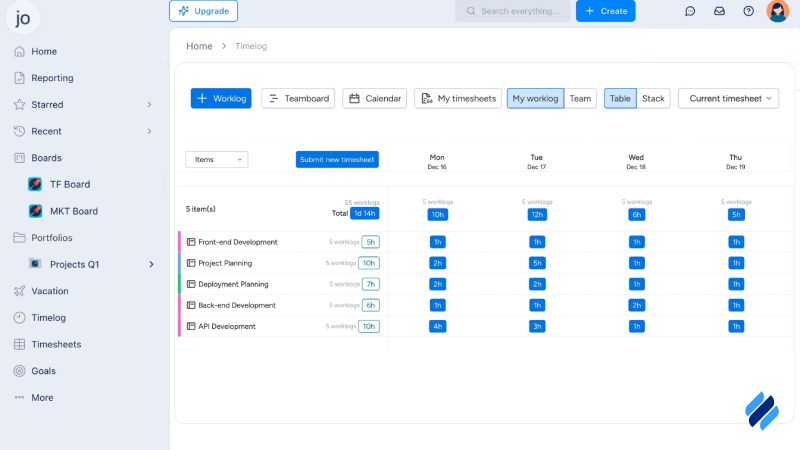
Allocate specific time slots for tasks to maintain focus and avoid multitasking. For example, dedicate mornings to high-priority tasks like content creation and afternoons to meetings or administrative work.
2. Pomodoro Technique
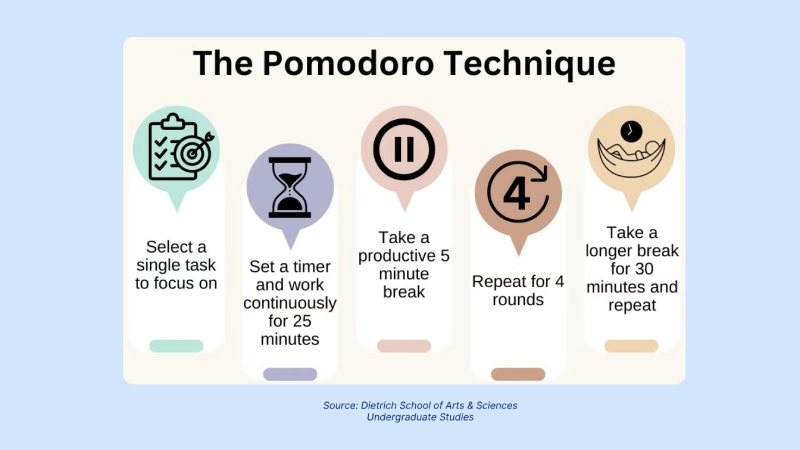
Work in 25-minute intervals followed by 5-minute breaks to boost focus and reduce fatigue. Tools like Toggl Track include built-in Pomodoro timers to support this method.
3. SMART Goal Setting
Set Specific, Measurable, Achievable, Relevant, and Time-bound goals to align tasks with business objectives. This approach ensures employees stay focused on meaningful work.
4. Task Batching
Group similar tasks, such as responding to emails or conducting research, to minimize context switching and improve efficiency.
5. Eisenhower Matrix
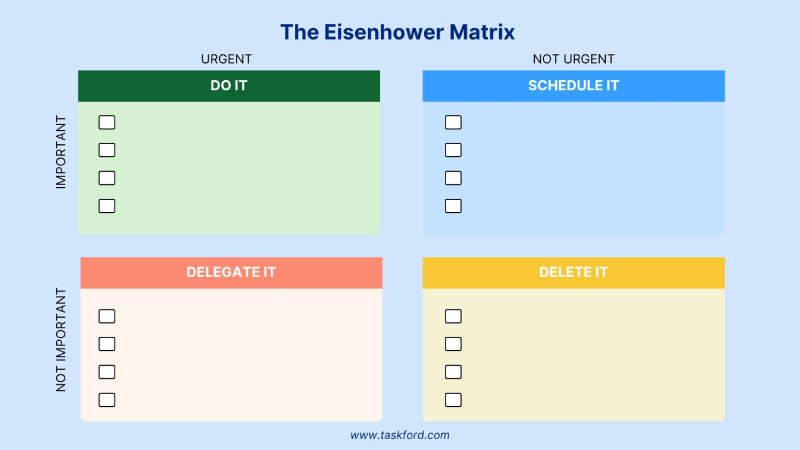
Prioritize tasks based on urgency and importance to focus on what matters most. Eisenhower Matrix helps employees avoid wasting time on low-value activities.
TaskFord’s Time Tracking Feature: Boosting Productivity
TaskFord is a comprehensive project management and resource planning platform that scales for teams of all sizes. Its time tracking features are designed to enhance productivity, accountability, and project management for teams of all sizes, freelancers, and remote workers. Here’s how it works and why it’s effective:
Simple Time Logging
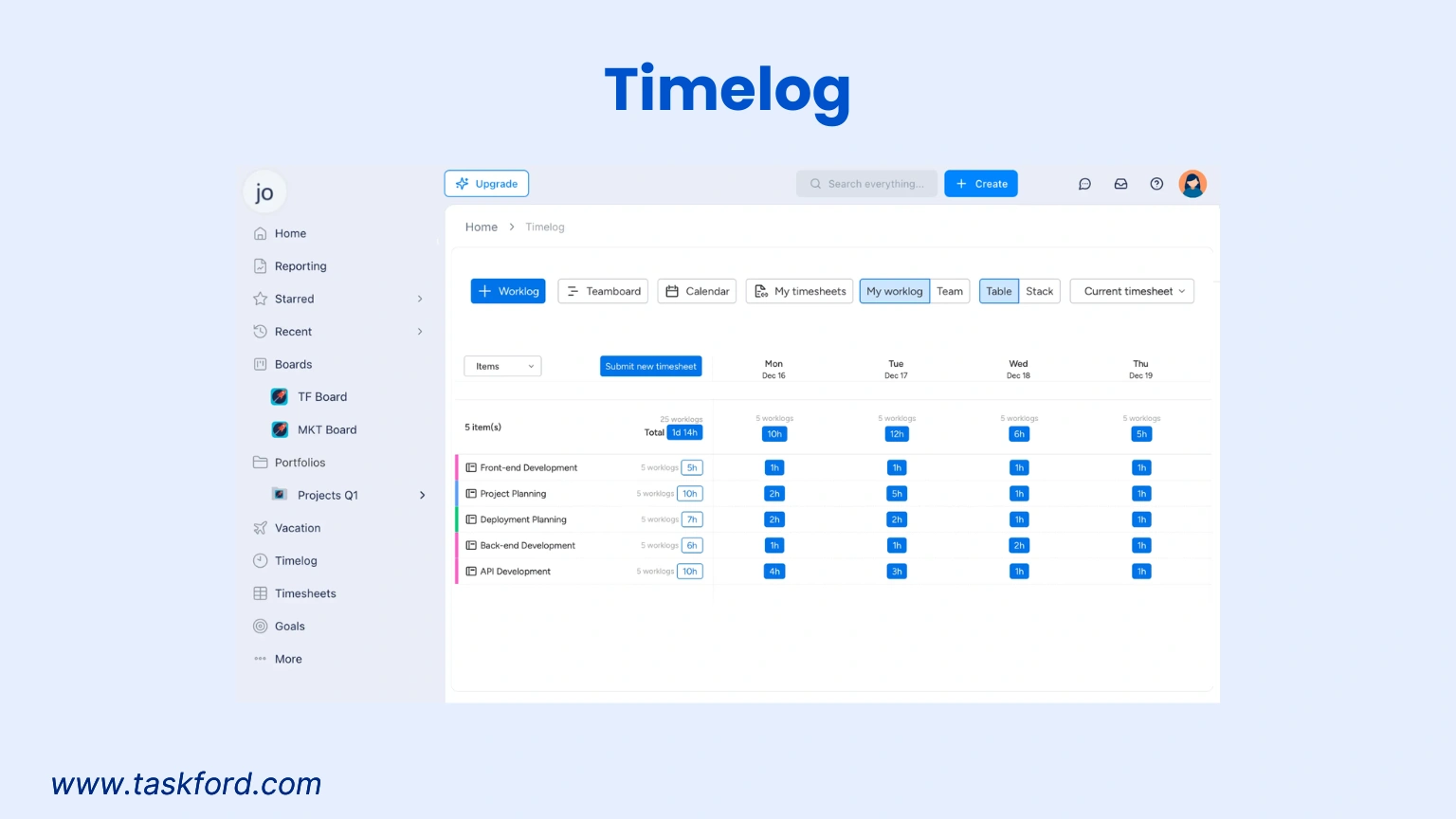
TaskFord’s timelog feature lets employees log hours for tasks, projects, or time off in a user-friendly table view. This centralized system ensures accurate tracking of billable and non-billable hours, ideal for freelancers using a free time tracking app for freelancers or teams managing multiple projects.
Timesheet Management

Employees can submit timesheets easily, while managers track approval status in real time, ensuring transparency and reducing payroll errors.
Real-Time Stopwatch
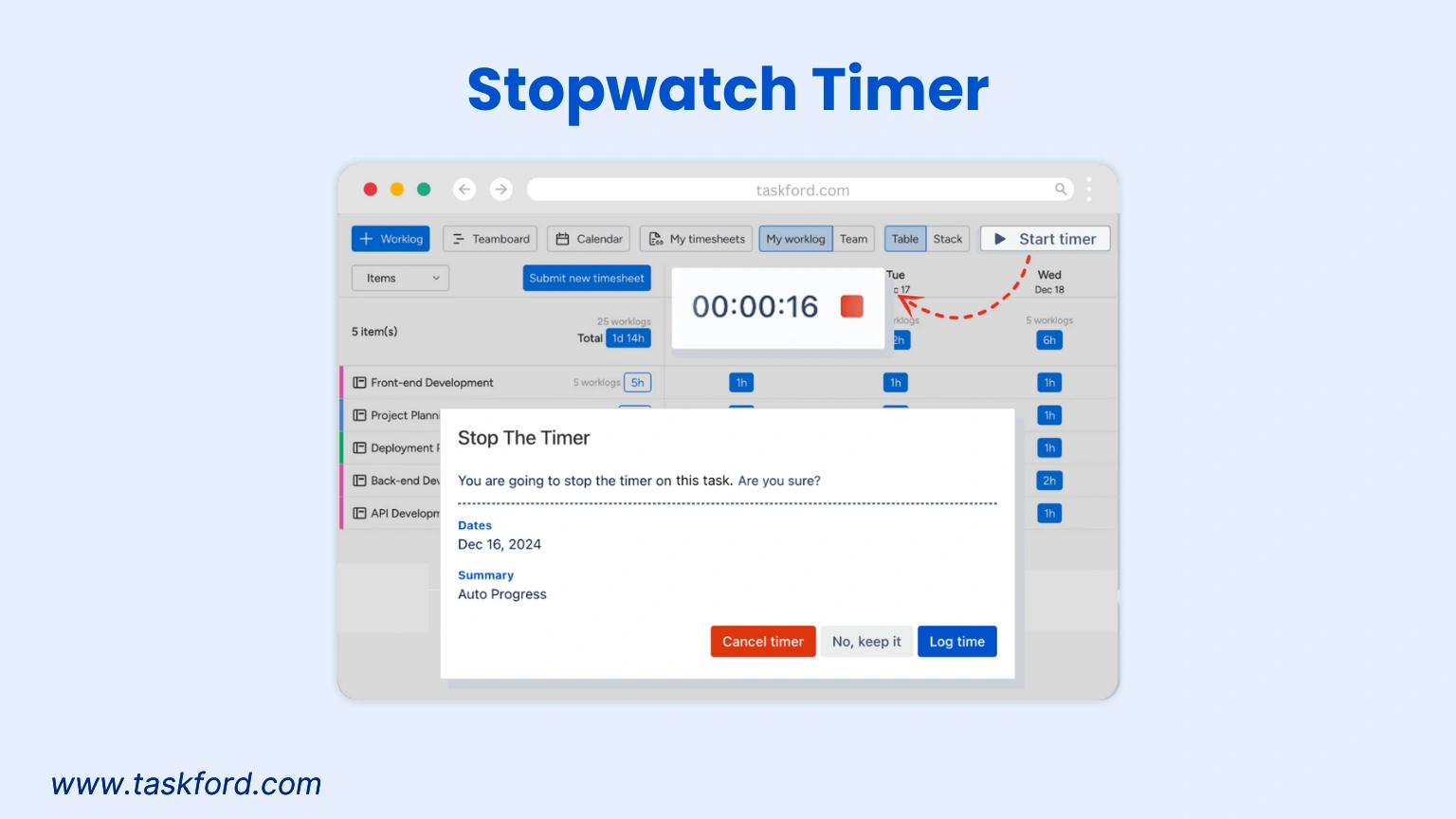
TaskFord offers real-time monitoring and a stopwatch timer, perfect for remote employee time tracking software. Automated timesheet generation minimizes manual entry, saving time for remote teams and contractors using a time tracking app for contractors.
Challenges of Employee Time Tracking and How to Overcome Them
While time tracking offers numerous benefits, it can also present challenges. Here’s how to address common issues:
- Employee Resistance: Some employees may view time tracking as micromanagement. Overcome this by clearly communicating the benefits, such as fair compensation and improved project planning. Involve employees in the tool selection process to increase buy-in.
- Data Overload: Too much data can overwhelm managers. Use tools with advanced reporting features to filter and analyze data effectively.
- Privacy Concerns: Biometric or productivity monitoring tools may raise privacy concerns. Address this by choosing tools with customizable settings to disable screenshot tracking, and being transparent about data usage.
- Inaccurate Data: Manual tracking or inconsistent logging can lead to inaccuracies. Automate time tracking to ensure accurate and consistent data collection.
The Future of Employee Time Tracking
As technology advances, employee time tracking is becoming more sophisticated. Artificial intelligence (AI) and automation are transforming how businesses monitor time and productivity. AI-powered tools can analyze time data to predict project timelines, identify inefficiencies, and suggest optimizations.
Right now, TaskFord is all about giving you the core tools you need to manage projects effectively. But we’re also working on bringing in smart, AI-powered features to keep up with how teams are evolving. Whether you try out the tools we’ve listed or keep an eye on what’s coming next from TaskFord, using AI in project management is a smart way to stay ahead in 2025 and beyond.
Conclusion
Employee time tracking is more than just a tool for monitoring hours; it’s a strategic asset that drives productivity, accountability, and efficiency. By choosing the right methods and tools, such as the best employee time tracking software or a free time tracking app for freelancers, businesses can gain valuable insights into how time is spent and make data-driven decisions to improve performance.
Whether you’re managing a remote team, overseeing contractors, or running a small business, implementing time tracking with effective time management techniques can transform how your organization operates.
Learn more
- 10 Practical Time Management Tools & Techniques That Actually Work
- What’s Next for Time Tracking Software? Key Innovation to Watch in 2025
- Manual vs. Automated Time Tracking: Which Method Saves You More Time?
Subscribe for Expert Tips
Unlock expert insights and stay ahead with TaskFord. Sign up now to receive valuable tips, strategies, and updates directly in your inbox.